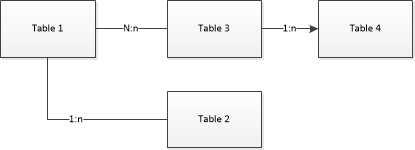Relational Database
The MySQL database
MySQL is one of the best known relational databases that can be found in the PHP environment. MySQL was developed by the Swedish company MySQL AB as early as 1994 and quickly became popular with many web developers worldwide. In 2008, Sun Microsystems took over MySQL AB and sold it in 2010 to Oracle, which still holds the rights to the software.
What is a relational database?
A relational database is a database that uses relationships between tables to store data. This means that the tables in a relational database are linked together so that the data can be easily retrieved by referring to a specific table. The idea is to have a single table (relation) with rows (tuples) that can be referenced by columns. Each row represents a single record or entity and each column represents a field or attribute of the record.

A database usually consists of several tables that are linked to each other via certain properties (primary and foreign key). The primary key is the column that uniquely identifies an entry in the table. The foreign key usually refers with an entry to a primary key of another table.

What is SQL (Structured Query Language)?
In order to access the desired content of a relational database, certain queries must be sent to the database server. With the development of relational databases in 1969 by the company IBM, the basis for the uniform database language SQL was created at the same time. Today, any relational database can be queried using SQL queries.
SELECT * FROM table
INSERT INTO table (NAME,ADDRESS,TEL,E-MAIL) VALUES ('Maier','63229 Egelsbach',''+49 0172 711,'info@yourdomain.com')
DELETE FROM table WHERE ID=1
UPDATE table set NAME='MÜLLER' WHERE ID=1
Architecture of a database server
A database server alone is actually useless. Only the actual program makes it a powerful tool for writing complex programs such as online stores, ticket systems or CMS systems.
Client-server principle
The client-server principle is a well-known architecture pattern that helps software developers make their applications more scalable, flexible and efficient. The core idea behind the client-server architecture is that the user interface (UI) and logic of an application are divided into two different components: the client and the server. In the traditional client-server model, the client is responsible for communicating with the server. It sends requests to the server and receives responses back. This approach has been adopted in a variety of technologies, including web development.
Why use a relational database?
Not every program uses a relational database to function. However, if you want to store data in a structured way and also retrieve it quickly, you can't get around a relational database. On the Internet, the vast majority of sites are likely to use a database, often a MySQL database. Well-known CMS systems like Wordpress, Typo3 or the marketplace software ebiz-trader use a MySQL database for storing data.
How to create a database?
You could read how to install and configure a MySQL database server in our mySQL tutorials.
Almost all web hosts nowadays offer at least one database with their web packages. Often you get a link to a MySQL tool called phpMyAdmin. phpMyAdmin is a free and open source relational database management system (RDBMS) written in PHP. It is a tool for managing MySQL databases. Its main purpose is to provide a web-based user interface for MySQL.
phpMyAdmin is very suitable for beginners, because it is a) almost always pre-installed with many web hosts b) easy to learn c) well documented
Alternativ befinden sich weitere leistungsstarke RDBMS auf dem Markt. You can read about them at SQL-RDBMS Editors. You can also find more information at SQL-Editors in the Marketplace.






 01.04.2022
-
mySQL-Tutorials
-
gorski@
01.04.2022
-
mySQL-Tutorials
-
gorski@

